To prove this point, behold the Voynich Manuscript, an example of what we assume is an illustrated book in a forgotten Earth language no one has been able to decode.
Over its recorded existence, the Voynich manuscript has been the object of intense study by many professional and amateur cryptographers, including some top American and British codebreakers of World War II fame (all of whom failed to decrypt a single word). - wikipedia
Tonight I viewed the 227 available pages. Based on the illustrations it is 1) mostly a botanical text with various single page data sheets on different types of plants, 2) astronomy notes with different zodiac symbols in the center of circles of stars, 3) pregnant naked ladies doing stuff with tubes and/or holding up stars. Some of it seemed like genealogy to me.
Here is a summary:
The Voynich Manuscript has been dubbed "The Most Mysterious Manuscript in the World". It is named after its discoverer,the American antique book dealer and collector, Wilfrid M. Voynich, who discovered it in 1912, amongst a collection of ancient manuscripts kept in villa Mondragone in Frascati, near Rome, which had been by then turned into a Jesuit College (closed in 1953).
No one knows the origins of the manuscript. Experts believe it is European based on the drawings. They believe it was written in between the 15th and 17th centuries. The manuscript is small, seven by ten inches, but thick, nearly 235 pages. - crystallinks
The full crystallinks article is pretty interesting. I also recommend the entire wikipedia aticle with details about code breaking attempts if you are interested in this topic. Some history:
Voynich took the MS to the United States and started a campaign to have it deciphered. Now, almost 100 years later, the Voynich manuscript still stands as probably the most elusive puzzle in the world of cryptography. Not a single word of this 'Most Mysterious Manuscript', written probably in the second half of the 15th Century, can be understood.Attached to the manuscript was a letter in Latin dated 1666 from Johannes Marcus Marci of Kronland, once rector of the Charles University of Prague, to the learned Jesuit Athanasius Kircher in Rome, offering the manuscript for decryption and mentioning that it had once been bought by Emperor Rudolf II of Bohemia (1552-1612) for 600 gold ducats. The letter further mentioned that it was believed that the author of the MS was Roger Bacon (the Franciscan friar who lived from 1214 to 1294).
Were Franciscan friar's drawing a lot of naked pregnant ladies back in the 1200's?
Another early owner of the MS was identified by Voynich when, on the lower margin of the first folio, under special illumination, the erased signature of Jacobus de Tepenec was found. Tepenec was one of Rudolf's private physicians and the director of his botanical gardens and he must have owned the manuscript between 1608, when he received his title "de Tepenec", and 1622, when he died. The MS has changed hands several times, and despite some minor gaps in our knowledge its path from the court of Rudolf to its final resting place, the Beinecke Rare book library of Yale University, can be traced fairly accurately.The MS became famous when, in the 1920's, William Romaine Newbold proposed a spectacular decipherment with which he meant to prove that it was indeed written by Roger Bacon, and that Bacon had not only dreamt of, but actually built microscopes and telescopes. When this 'solution' of the MS was disproven by John M. Manly in 1931, the MS gradually became a pariah in world of mediaeval studies. ...
In 1961 the book was acquired by H. P. Kraus (a New York book antiquarian) for the sum of $24,500. He later valued at $160,000, but unable to find a buyer he donated it to Yale University. Though officially registered as MS 408, it is still best known as the Voynich Manuscript. - voynich
Edithsherwood.com shows some correlations to real plants:
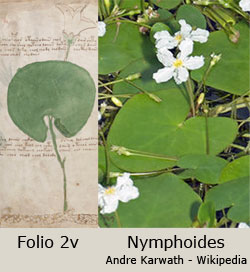
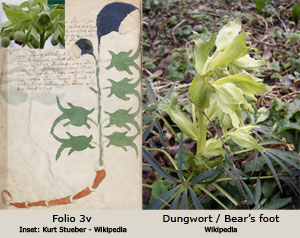
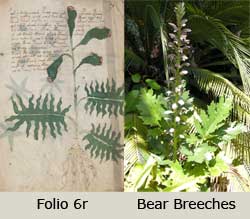
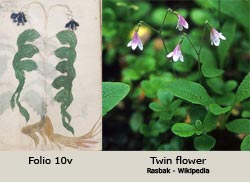
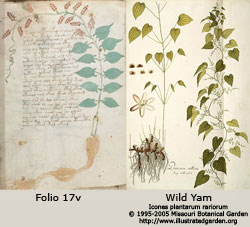
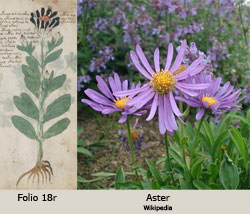
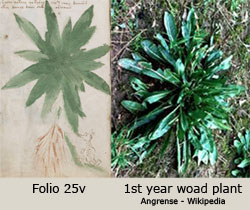
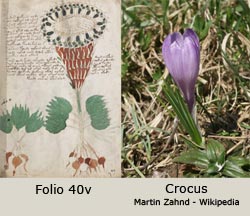
In late 2003, Zbigniew Banasik of Poland proposed that the manuscript is plaintext written in the Manchu language and gave a proposed incomplete translation of the first page of the manuscript.[11]
His proposed translation says roughly that "children are needed for the nation, so heat it up and get busy producing children. Keeping doing it so much that you need some medicinal cream. Do it again and again, all the way to the end. Wait two days if you must, then get back at it, penetrating, warming, and procreating."
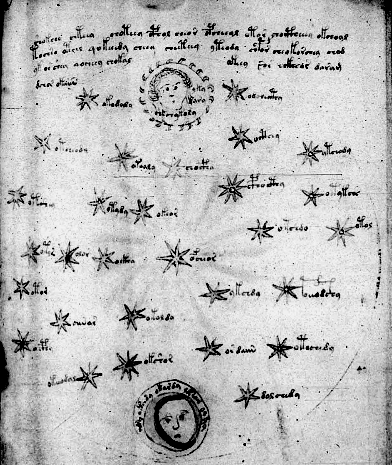
2 comments:
[...] Posted by Xeno on March 9, 2009 This new music video from David Byrne of the Talking Heads seems inspired by the mysterious Voynich Manuscript. [...]
My interest in the Voynich Manuscript is based on the occult, herbalism, astrology and fertility. The 'medicinal cream' mentioned could refer to extract of Wild Yam, which is a provider of progesterone. In times of estrogen overload, infertility and poor libido are two of the effects. Wild Yam (which is presented in the MS) is reputed to help balance the hormones which I guess would have been skewed due to the excessive copulation and reproducing. The Medicinal Cream could even have been a simple lubricant to be used after two days of recuperation, maybe Aloe Vera, which some Westerners I know use in an emergency.
If the MS was written (contrived?) between the 15th and 17th centuries, it suggests to me that because the Bubonic Plague took away almost the entire population the survivors were encouraged to repopulate in a gargantuan way.
Just two cents worth from an Aussie woman who cleans rich people's houses for a living.
Post a Comment